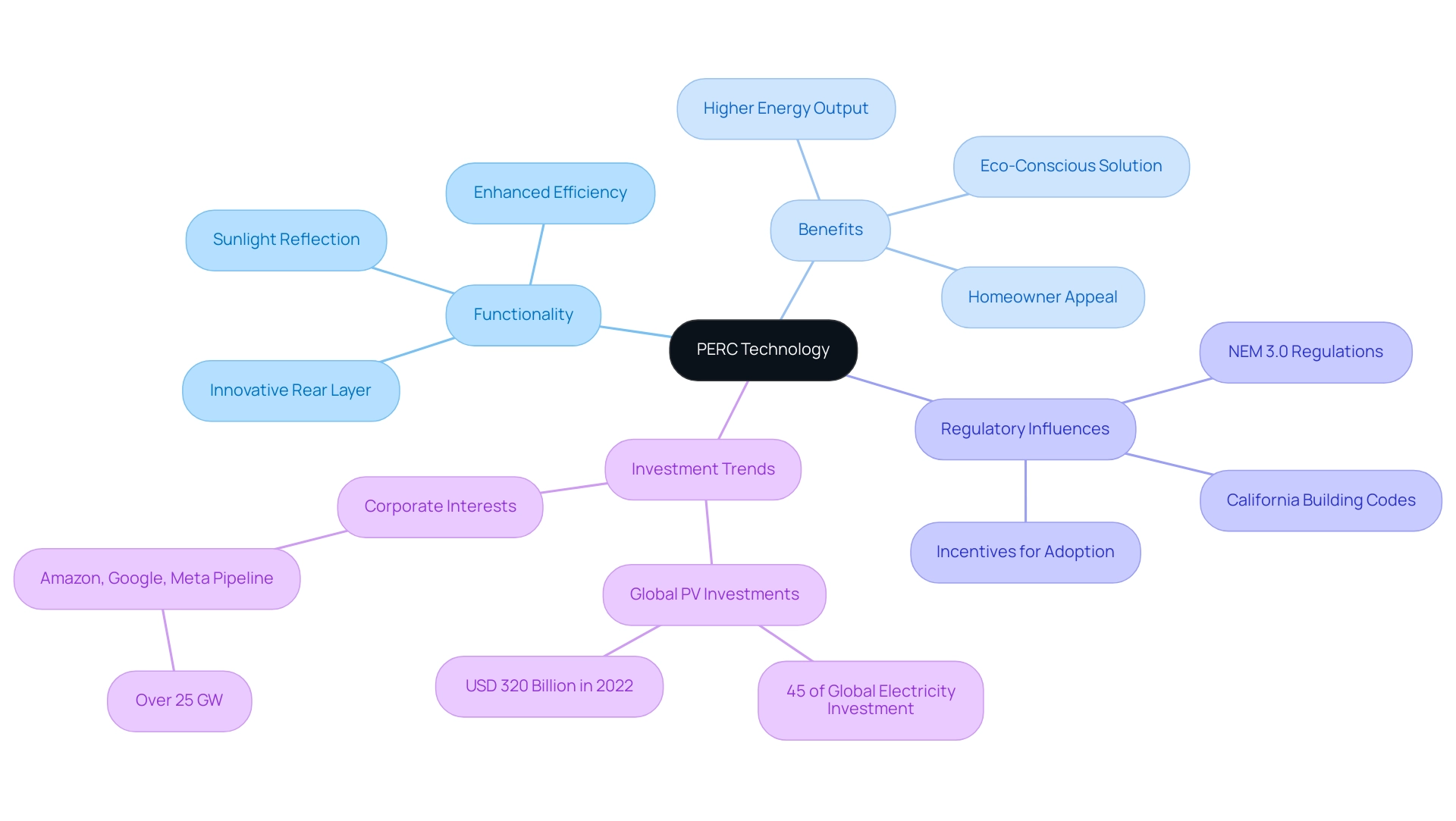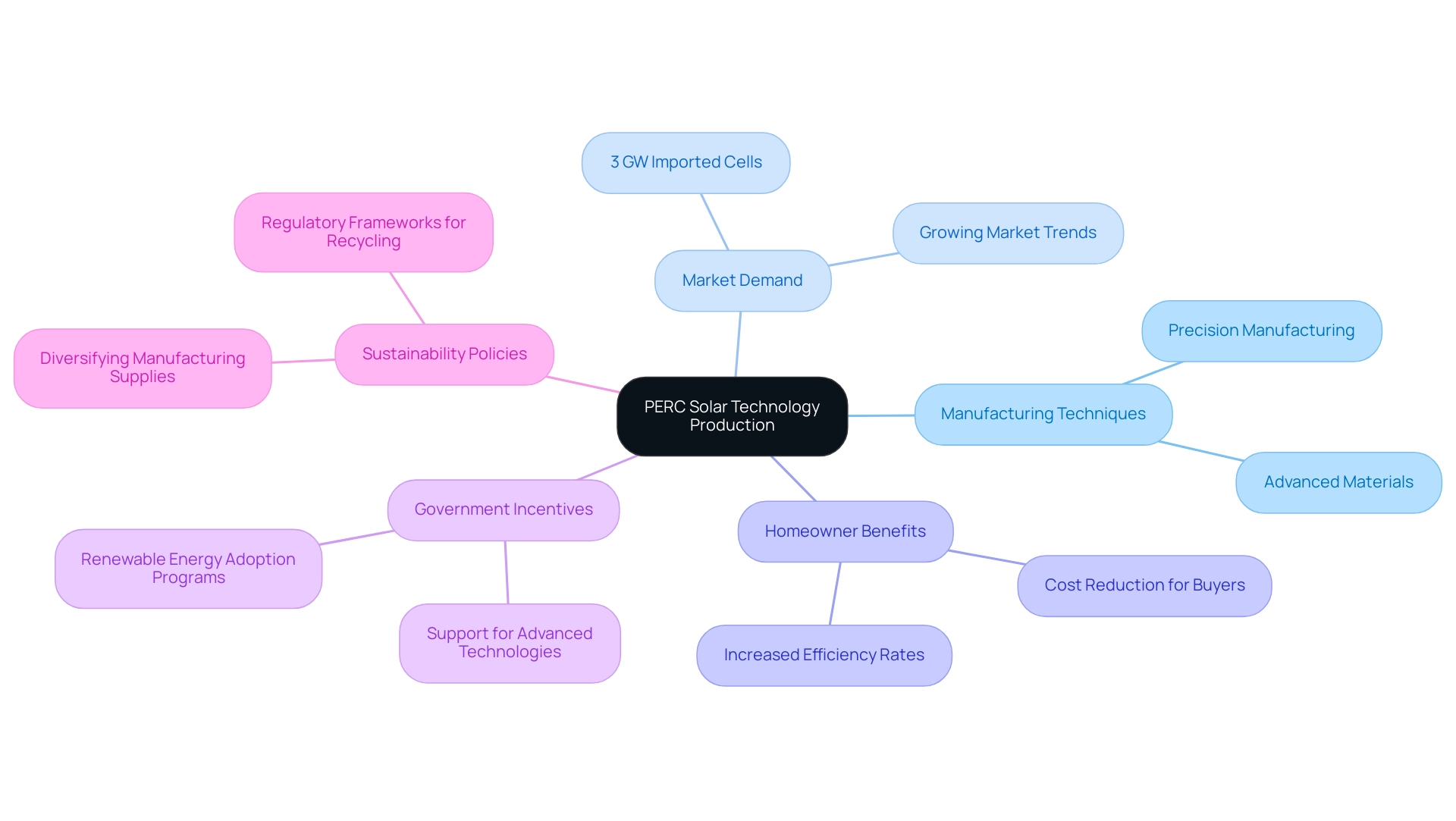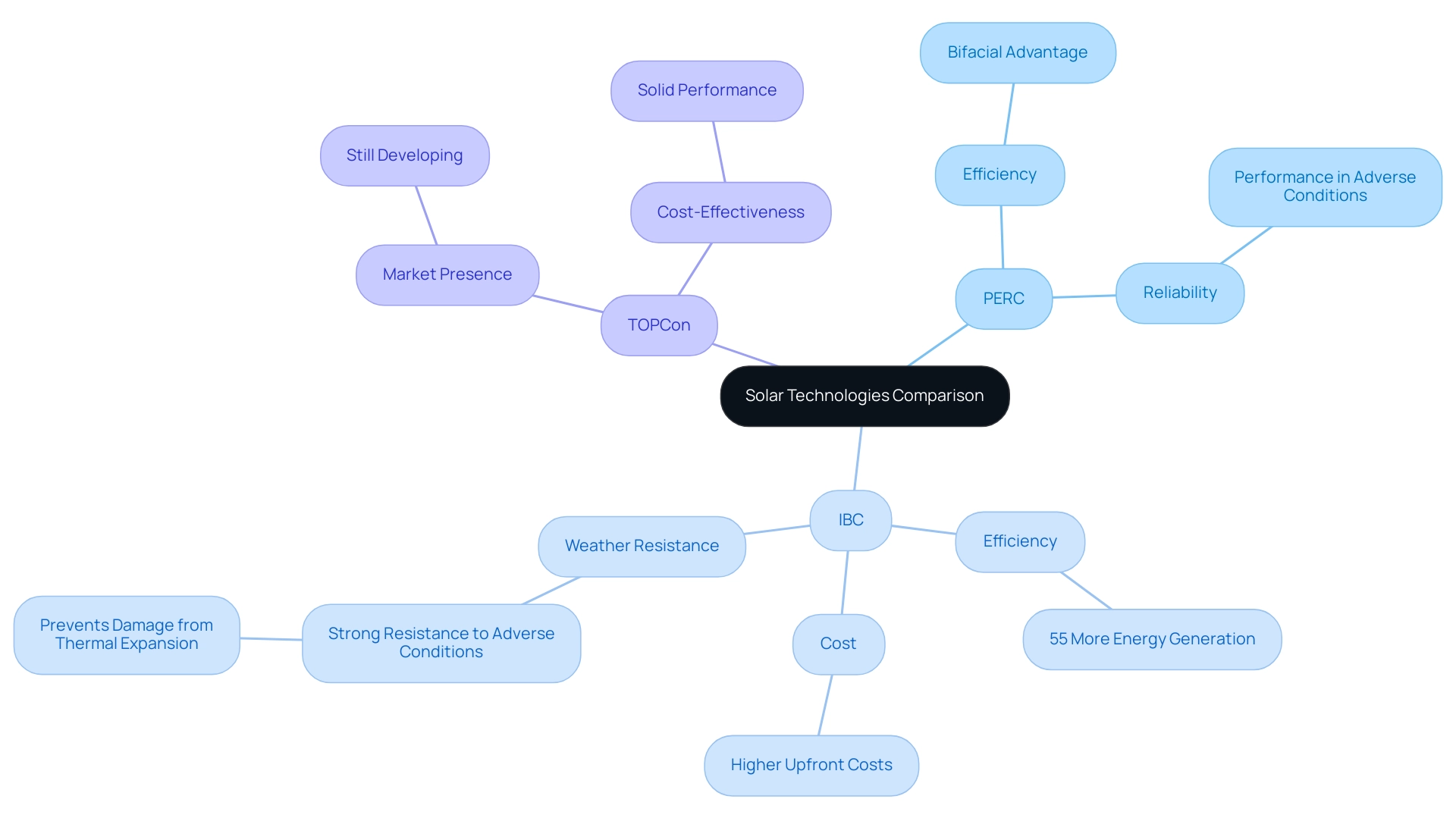Overview
PERC technology, or Passivated Emitter and Rear Cell technology, significantly enhances solar cell efficiency by incorporating a reflective layer on the rear side that boosts electricity conversion from sunlight, making it a preferred choice for modern solar installations. The article supports this by detailing how PERC cells can produce up to 20% more power than traditional cells and perform well in low-light conditions, highlighting their advantages for homeowners aiming for energy independence and sustainability.
Introduction
In the quest for sustainable energy solutions, PERC (Passivated Emitter and Rear Cell) technology has emerged as a game-changer for homeowners eager to harness the sun’s power more effectively. Unlike traditional solar panels, PERC cells feature a unique design that maximizes energy conversion, reflecting unabsorbed sunlight back into the cell for improved efficiency. This innovation not only offers significant energy savings but also positions homeowners to take control of their energy future amidst evolving regulations and incentives.
As the solar landscape continues to expand, understanding the benefits and advancements of PERC technology is essential for anyone looking to make informed decisions about their solar investments. With leading companies and eco-conscious homeowners alike embracing this technology, the future of solar energy is brighter than ever.
Understanding PERC Technology: Basics and Functionality
The technology known as Passivated Emitter and Rear Cell represents a significant advancement in solar panel innovation, enhancing efficiency in a way that traditional solar cells simply can’t match. So, what makes these cells so special? Unlike conventional panels that rely on a basic front and back surface, these cells incorporate an innovative layer on the rear side.
This clever addition reflects any sunlight that isn’t initially absorbed back into the cell, boosting its ability to convert sunlight into electricity. As a result, PERC technology has quickly become a favorite among modern installations, proving especially beneficial for homeowners looking to maximize their energy output in an eco-conscious manner. To ascertain how much photovoltaic capacity you require for your residence, contemplate elements such as your average power usage, roof dimensions, and local sunlight availability.
Furthermore, California’s building codes and the recent NEM 3.0 regulations greatly influence the adoption of renewable sources, providing opportunities for homeowners to take advantage of incentives and simplify their installations. With 1.1 GW of residential photovoltaic systems installed in Q3 2024, the use of innovative methods is becoming more significant in our pursuit of independence in power. Major corporations like Amazon, Google, and Meta are also advancing, with a combined contracted pipeline of over 25 GW, highlighting the increasing interest and investment in renewable energy.
For property owners, grasping these basics not only emphasizes the benefits of these cells compared to previous models but also clarifies their significance in the wider framework of renewable advancements. With worldwide photovoltaic investments exceeding USD 320 billion in 2022, it’s evident that adopting advanced technologies is crucial for optimizing efficiency and utilizing the complete capability of sunlight. When evaluating renewable options, let Powercore Electric assist you in managing your power future with our premium residential panel installation services throughout California.
Advantages of PERC Solar Cells: Efficiency and Performance Gains
High-efficiency photovoltaic cells are a transformative solution for homeowners aiming to enhance power efficiency while adopting eco-friendly practices. These innovative panels can produce up to 20% more power compared to traditional solar cells, making them an excellent choice for anyone wishing to reduce utility costs and enhance power independence. One of the standout features of this technology is its exceptional performance in low-light conditions, which is particularly beneficial for regions that don’t bask in consistent sunlight.
This indicates that even on overcast days, homeowners can still produce a substantial amount of power. Furthermore, although these panels may have a somewhat increased initial expense, the long-term savings on electricity are indisputable. A recent study highlighted that a 1-cm, 2-terminal, double-junction perovskite/Si cell fabricated by LONGi achieved an impressive 33.9% efficiency, as measured by NREL.
Furthermore, it’s important to mention that Cu (In, Ga)Se2 thin-film concentrator photovoltaic cells have an efficiency of 21.5%, offering a wider context for efficiency comparisons. This highlights the extraordinary potential of PERC technology to not only decrease utility costs but also aid in creating a more sustainable planet.
Investing in PERC technology for photovoltaic cells not only promotes job creation but also has beneficial effects on public health by decreasing dependence on fossil fuels and reducing greenhouse gas emissions. With robust policy backing promoting photovoltaic deployment worldwide, including initiatives like the Biden-Harris administration’s Program for All aimed at enhancing fair access to renewable resources, homeowners can feel fulfilled knowing they are participating in a clean power initiative.
At Powercore Electric, we take pride in providing customized energy solutions supported by local expertise and unparalleled quality craftsmanship, ensuring your shift to clean energy is smooth and advantageous for both your finances and the planet.
The Production Landscape of PERC Solar Technology
Producing photovoltaic cells using PERC technology is an exciting venture that showcases advanced manufacturing techniques, involving specialized materials and cutting-edge processes. These high-tech facilities prioritize precision, ensuring that every cell meets the stringent requirements for efficiency and durability. With the surge in demand for photovoltaic technology—evidenced by the more than 3 GW of cells imported into the United States in Q2 2024—manufacturers are ramping up production to keep pace with this growing market.
As Piotr Bojek, a lead author, highlights,
Placing the world on a trajectory to attain net zero emissions necessitates photovoltaic technology to expand globally on an even greater scale, raising concerns about the security of manufacturing supply for achieving such rapid growth rates.
This growing acceptance of photovoltaic innovation among top manufacturers not only improves their product lines but also results in reduced expenses for buyers, making renewable power more attainable than ever for homeowners. Moreover, the incorporation of PERC technology enhances panel functionality, resulting in increased efficiency rates and improved performance, which are essential for homeowners seeking to optimize their savings.
Additionally, government programs that incentivize renewable energy adoption further support homeowners in investing in these advanced technologies. There’s a pressing need for policies that focus on diversifying manufacturing and raw material supplies, essential for ensuring the security of photovoltaic supplies. The industry is acknowledging the significance of regulatory frameworks that outline responsibilities for PV panel recycling, ensuring that sustainability stays at the forefront of this technological evolution.
These advancements enhance both the economic and ecological advantages of heating systems, including efficiency integration, which is crucial for environmentally aware homeowners seeking to invest in sustainable options.
PERC vs. Other Solar Technologies: A Comparative Analysis
When comparing perc technology (Passivated Emitter and Rear Cell) methods with other solar systems like IBC (Interdigitated Back Contact) and TOPCon (Tunnel Oxide Passivated Contact), some clear differences emerge.
- IBC cells are renowned for their impressive efficiency, delivering up to 55% more energy than conventional systems over 25 years, making them a compelling option for homeowners willing to invest upfront. However, they often come with a higher price tag and may not be as easily accessible for residential installations.
- TOPCon innovation, while newer and showing great promise, is still developing its market presence. Meanwhile, this technology stands out as the most widely adopted choice, thanks to its solid performance and cost-effectiveness. For homeowners, it’s crucial to consider these factors.
These panels can produce up to 18% more energy than monofacial photovoltaic cells, making them an appealing choice. Furthermore, mono crystalline panels offer enhanced performance and technical characteristics in comparison to poly crystalline panels, guaranteeing a beneficial option. The established track record of perc technology means you can expect dependable power generation, even in less-than-ideal weather conditions.
A notable case study on IBC panels highlights their strong resistance to adverse weather conditions, ensuring stability and reliability. This advanced design prevents damage from thermal expansion and contraction, ensuring consistent power generation under challenging environmental conditions. As highlighted by Wolf River Electric, ‘While it may have a higher up-front cost, over time, you’ll see a higher return on your investment.’
Moreover, taking into account governmental initiatives that provide benefits for renewable energy installation can greatly improve the cost-effectiveness of these solutions. Eco-conscious homeowners should also explore the latest battery options available for efficient power storage, which can complement their solar systems. Every innovation has its distinctive benefits and compromises, and dedicating time to evaluate them will assist you in making a knowledgeable decision for your power requirements.
The Future of PERC Technology: Innovations and Trends
Looking towards the future, advancements in perc technology are on the brink of exciting innovations that promise to enhance efficiency and lower production costs. With recent insights into sunlight power solutions, such as Tesla home chargers, battery storage options, and top panel cleaning services, homeowners are increasingly empowered to optimize their usage. One promising trend is the incorporation of intelligent technologies with photovoltaic panels, enabling you to track your power generation in real-time.
This ability not only encourages more sustainable living practices but also aligns with various government initiatives supporting energy adoption. Additionally, breakthroughs in materials science are anticipated to yield even more efficient energy cells that capture sunlight more effectively. It’s noteworthy that utility-scale plants represented approximately half of global photovoltaic capacity additions in 2022, emphasizing the sector’s significant impact.
With worldwide photovoltaic investments exceeding USD 320 billion in 2022 and ambitious governmental goals propelling expansion, remaining knowledgeable about these advancements assists environmentally conscious homeowners in anticipating the advantages future energy innovations will deliver. As emphasized by Marubeni, the drive for innovation encompasses utilizing blockchain technology to monitor panel lifecycles, ensuring that panels are reused whenever feasible instead of merely recycled. Furthermore, understanding how solar panels work, as detailed in comprehensive guides, can greatly enhance your decision-making process.
Embracing these trends positions you to lead the way in sustainable energy practices.
Conclusion
The advancements in PERC (Passivated Emitter and Rear Cell) technology represent a significant leap forward in solar energy efficiency, offering homeowners a remarkable opportunity to harness the sun’s power more effectively. By reflecting unabsorbed sunlight back into the cell, PERC panels can generate up to 20% more energy than traditional options, making them an excellent choice for those looking to cut utility costs and enhance energy independence.
Moreover, the versatility of PERC technology shines in low-light conditions, ensuring that even on cloudy days, homeowners can still benefit from substantial power generation. This capability, coupled with the long-term savings that come from investing in these innovative solar cells, underscores the importance of embracing modern solar solutions. As the demand for solar energy continues to rise, understanding the production landscape and the comparative advantages of PERC over other technologies further empowers homeowners to make informed decisions.
Looking ahead, the future of PERC technology is bright, with ongoing innovations set to enhance efficiency and lower production costs. By staying informed about these developments and considering the integration of smart technologies, homeowners can optimize their energy usage and contribute to a greener planet. Embracing PERC technology not only paves the way for energy independence but also aligns with broader efforts to create a sustainable future. With such promising advancements on the horizon, now is the perfect time to invest in solar solutions that truly empower individuals and communities alike.







